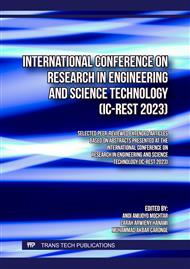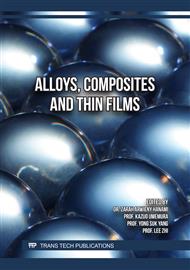[1]
C.D. Boland, R.L. Hexemer, I.W. Donaldson, and D.P. Bishop, "Industrial processing of a novel Al-Cu-Mg powder metallurgy alloy," Mater. Sci. Eng. A, vol. 559, p.902–908, 2013.
DOI: 10.1016/j.msea.2012.09.049
Google Scholar
[2]
A. Gökçe, F. Findik, and A. O. Kurt, "Microstructural examination and properties of premixed Al-Cu-Mg powder metallurgy alloy," Mater. Charact., vol. 62, no. 7, p.730–735, 2011.
DOI: 10.1016/j.matchar.2011.04.021
Google Scholar
[3]
M. Qian and G. B. Schaffer, Sintering of aluminium and its alloys. Woodhead Publishing Limited, 2010.
DOI: 10.1533/9781845699949.3.291
Google Scholar
[4]
J. M. Martín and F. Castro, "Liquid phase sintering of P/M aluminium alloys: Effect of processing conditions," J. Mater. Process. Technol., vol. 143–144, no. 1, p.814–821, 2003.
DOI: 10.1016/S0924-0136(03)00335-2
Google Scholar
[5]
G. B. Schaffer, T. B. Sercombe, and R. N. Lumley, "Liquid phase sintering of aluminum alloys," Mater. Chem. Phys., vol. 67, no. 1–3, p.85–91, 2001.
DOI: 10.1016/S0254-0584(00)00424-7
Google Scholar
[6]
M. C. Oh and B. Ahn, "Effect of Mg composition on sintering behaviors and mechanical properties of Al-Cu-Mg alloy," Trans. Nonferrous Met. Soc. China (English Ed., vol. 24, no. SUPPL. 1, pp. s53–s58, 2014.
DOI: 10.1016/S1003-6326(14)63288-X
Google Scholar
[7]
G. A. W. Sweet et al., "Microstructural evolution of a forged 2XXX series aluminum powder metallurgy alloy," Mater. Charact., vol. 151, no. February, p.342–350, 2019.
DOI: 10.1016/j.matchar.2019.03.033
Google Scholar
[8]
K. R. Ravi, S. Manivannan, G. Phanikumar, B. S. Murty, and S. Sundarraj, "Influence of Mg on grain refinement of near eutectic Al-Si alloys," Metall. Mater. Trans. A Phys. Metall. Mater. Sci., vol. 42, no. 7, p.2028–2039, 2011.
DOI: 10.1007/s11661-010-0600-0
Google Scholar
[9]
B. Torres, M. Lieblich, J. Ibáñez, and A. García-Escorial, "Mechanical properties of some PM aluminide and silicide reinforced 2124 aluminium matrix composites," Scr. Mater., vol. 47, no. 1, p.45–49, 2002.
DOI: 10.1016/S1359-6462(02)00095-7
Google Scholar
[10]
Y. Sahin and S. Murphy, "The effect of fibre orientation of the dry sliding wear of borsic-reinforced 2014 aluminium alloy," J. Mater. Sci., vol. 31, no. 20, p.5399–5407, 1996.
DOI: 10.1007/BF01159309
Google Scholar
[11]
P. Ashwath, J. Joel, M. Anthony Xavior, and H. G. Prashantha Kumar, "Effect of SiC and Al2O3 particles addition to AA 2900 and AA 2024 MMC's synthesized through microwave sintering," Mater. Today Proc., vol. 5, no. 2, p.7329–7336, 2018.
DOI: 10.1016/j.matpr.2017.11.402
Google Scholar
[12]
T. Miyajima and Y. Iwai, "Effects of reinforcements on sliding wear behavior of aluminum matrix composites," Wear, vol. 255, no. 1–6, p.606–616, 2003.
DOI: 10.1016/S0043-1648(03)00066-8
Google Scholar
[13]
J. Satish and K. G. Satish, "Preparation of magnesium metal matrix composites by powder metallurgy process," IOP Conf. Ser. Mater. Sci. Eng., vol. 310, no. 1, 2018.
DOI: 10.1088/1757-899X/310/1/012130
Google Scholar
[14]
G. Rodríguez-Cabriales et al., "Synthesis and characterization of Al-Cu-Mg system reinforced with tungsten carbide through powder metallurgy," Mater. Today Commun., vol. 22, no. July, p.100758, 2020.
DOI: 10.1016/j.mtcomm.2019.100758
Google Scholar
[15]
N. Karthikeyan, B. Radha Krishnan, A. VembathuRajesh, and V. Vijayan, "Experimental analysis of Al-Cu-Si metal matrix composite by powder-metallurgy process," Mater. Today Proc., vol. 37, no. Part 2, p.2770–2774, 2020.
DOI: 10.1016/j.matpr.2020.08.643
Google Scholar
[16]
M. J. Styles, C. R. Hutchinson, Y. Chen, A. Deschamps, and T. J. Bastow, "The coexistence of two S (Al 2CuMg) phases in Al-Cu-Mg alloys," Acta Mater., vol. 60, no. 20, p.6940–6951, 2012.
DOI: 10.1016/j.actamat.2012.08.044
Google Scholar
[17]
R. N. Lumley, T. B. Sercombe, and G. B. Schaffer, "Surface oxide and the role of magnesium during the sintering of aluminum," Metall. Mater. Trans. A Phys. Metall. Mater. Sci., vol. 30, no. 2, p.457–463, 1999.
DOI: 10.1007/s11661-999-0335-y
Google Scholar
[18]
A. Sangghaleh and M. Halali, "Effect of magnesium addition on the wetting of alumina by aluminium," Appl. Surf. Sci., vol. 255, no. 19, p.8202–8206, 2009.
DOI: 10.1016/j.apsusc.2009.05.044
Google Scholar
[19]
J. C. Lee, J. P. Ahn, Z. Shi, J. H. Shim, and H. I. Lee, "Methodology to design the interfaces in SiC/Al composites," Metall. Mater. Trans. A Phys. Metall. Mater. Sci., vol. 32, no. 6, p.1541–1550, 2001.
DOI: 10.1007/s11661-001-0241-4
Google Scholar
[20]
C. Yuan et al., "Enhanced ductility by Mg addition in the CNT/Al-Cu composites via flake powder metallurgy," Mater. Today Commun., vol. 26, p.101854, 2021.
DOI: 10.1016/j.mtcomm.2020.101854
Google Scholar
[21]
T. Qiu, M. Wu, Z. Du, G. Chen, L. Zhang, and X. Qu, "Microstructure evolution and densification behaviour of powder metallurgy Al–Cu–Mg–Si alloy," Powder Metall., vol. 63, no. 1, p.54–63, 2020.
DOI: 10.1080/00325899.2020.1719688
Google Scholar
[22]
M. Rahimian, N. Parvin, and N. Ehsani, "Investigation of particle size and amount of alumina on microstructure and mechanical properties of Al matrix composite made by powder metallurgy," Mater. Sci. Eng. A, vol. 527, no. 4–5, p.1031–1038, 2010.
DOI: 10.1016/j.msea.2009.09.034
Google Scholar
[23]
R. M. German, "Powder Metallurgy Science," 1984.
Google Scholar



